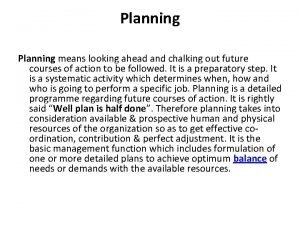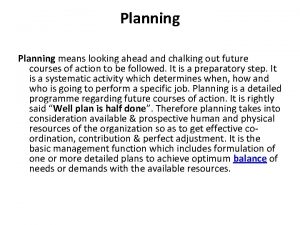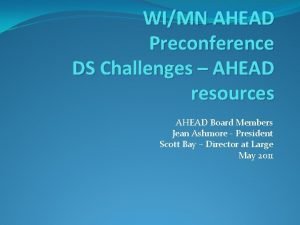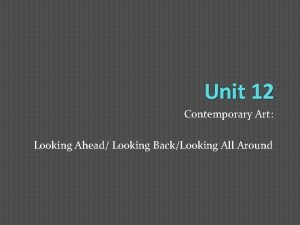Planning means looking ahead and chalking out future










- Slides: 10

Planning means looking ahead and chalking out future courses of action to be followed. It is a preparatory step. It is a systematic activity which determines when, how and who is going to perform a specific job. Planning is a detailed programme regarding future courses of action. It is rightly said “Well plan is half done”. Therefore planning takes into consideration available & prospective human and physical resources of the organization so as to get effective coordination, contribution & perfect adjustment. It is the basic management function which includes formulation of one or more detailed plans to achieve optimum balance of needs or demands with the available resources.

Urwick “Planning is a mental predisposition to do things in orderly way, to think before acting and to act in the light of facts rather than guesses”. Planning is deciding best alternative among others to perform different managerial functions in order to achieve predetermined goals.

Koontz & O’Donell “Planning is deciding in advance what to do, how to do and who is to do it. Planning bridges the gap between where we are to, where we want to go. It makes possible things to occur which would not otherwise occur”.

Importance of Planning • Good planning is good stewardship. Success in any endeavor requires careful preparation and planning. Without proper planning and preparation, failure is almost guaranteed • Good planning conserves resources, prevents wasted effort, and saves time and money. Good planning prevents small problems from becoming big problems.

planning function Ø Provides Direction Ø Provides opportunity to analyze alternative Ø courses of action Ø Reduces uncertainties Ø Minimizes impulsive and arbitrary decisions Ø King-pin function Ø Resource Allocation Ø Resource use efficiency Ø Adaptive responses Ø Anticipative action Ø Integration

Characteristic of planning Ø Planning is goal-oriented Ø Planning is looking ahead Ø Planning is an intellectual process Ø Planning involves choice & decision making Ø Planning is the primary function of management / Primacy of Planning Ø Planning is a Continuous Process Ø Planning is all Pervasive Ø Planning is designed for efficiency Ø Planning is Flexible

Steps in Planning Function • • • Establishment of objectives Establishment of Planning Premises Choice of alternative course of action Formulation of derivative plans Securing Co-operation Follow up/Appraisal of plans

Advantages of Planning Ø Planning facilitates management by objectives Ø Planning minimizes uncertainties Ø Planning facilitates co-ordination Ø Planning improves employee’s moral Ø Planning helps in achieving economies Ø Planning facilitates controlling Ø Planning provides competitive edge Ø Planning encourages innovations

Disadvantages of planning • • • Internal Limitations Misdirected Planning Time consuming Probability in planning False sense of security Expensive

External Limitations of Planning Ø Political Climate- Change of government from Congress to some other political party, etc. Ø Labour Union- Strikes, lockouts, agitations. Ø Technological changes- Modern techniques and equipments, computerization. Ø Policies of competitors- Eg. Policies of Coca Cola and Pepsi. Ø Natural Calamities- Earthquakes and floods. Ø Changes in demand prices- Change in fashion, change in tastes, change in income level, demand falls, price falls, etc.



















